How to Set Up Google Analytics Goals & 10 Tips to Get Ahead via @sejournal, @joshuacmccoy
Learn how Google Analytics goals give insight into your website audience. Get essential information about them, and whether they are converting toward your site objectives. The post How to Set Up Google Analytics Goals & 10 Tips to Get...

How well you understand your website traffic will ultimately determine the success of your marketing and advertising efforts.
And there’s more involved in performance analysis than simply reviewing user behavior metrics such as bounce rate, time on site, and pages per session.
You may unknowingly be falling victim to high traffic generation and low site engagement due to a lack of call to action and site usability.
This lack of intelligence can easily be solved via the introduction of goal set up in Google Analytics.
Before we set up goals in our account, let’s take a look at what makes a good goal and how we define our own individual website success.
Determining Your Site Goals
Setting up goals in your analytics platform is rather easy; the difficult part is having all decision-makers agree on the objectives of the site.
Through collaboration, your team should determine how the website needs to help the company achieve its overall goals.
Advertisement
Continue Reading Below
More importantly, does the website achieve its goals?
If not, goal tracking in Google Analytics (GA) will help you understand if your site is helping you to move forward or causing a lot of confusion for your users.
In your mutual consideration of site goals, it’s important that all parties understand the difference between key performance indicators (KPIs) and site goals.
A site goal is the overall end result that you desire from a site user’s journey through your sale. This may be a sale, a lead generation submission, a web chat session, etc.
Key performance indicators are metrics that help us understand whether we’re moving closer to reaching a goal (i.e., items added to a cart, video starts, clicks to chat, or contact an organization).
It is fine to monitor KPIs via event tracking in GA, but these should not be tracked as goals.
Before departing the meeting room, identify what these goals are worth to your organization. This will come in handy later.
Advertisement
Continue Reading Below
For example, determine how many leads reach a sale. What is that sale worth? What are your profit margins?
Now that you know what a goal conversion is worth, you can gain a better understanding of the return you are seeing from your digital marketing and advertising efforts.
Setting Up Goals in Google Analytics
Now that we have agreed upon goals for our site, we can move into Google Analytics, within the Admin > Goals section to set up our goals.
 Screenshot of Google Analytics, August 2021
Screenshot of Google Analytics, August 2021
You will be given the opportunity to choose between a template-based goal or a custom goal format.
These are basically the same and from my experience, it is easier to choose the custom format.
 Screenshot from Google Analytics, July 2021
Screenshot from Google Analytics, July 2021
You are then given the chance to choose between Destination, Duration, Pages/Screen per Session, or Event as a Goal Type.
Typically, you want to choose Destination.
I urge you to not set goals based on pages per session or visit duration. These are not goals; they are KPI metrics.
Advertisement
Continue Reading Below
Someone visiting five pages on your site does not create sales or generate leads. It likely helps you but it is not the end goal.
 Screenshot from Google Analytics, August 2021
Screenshot from Google Analytics, August 2021
Moving into the Destination goal, we have to identify the structure of our goal destination.
There are a lot of important entries here that you must accurately complete.
 Screenshot from Google Analytics, August 2021
Screenshot from Google Analytics, August 2021
You will be given the chance to format what constitutes a destination URL rule that will fire a goal. There are three choices that will help meet your goal destination needs.
Advertisement
Continue Reading Below
Examples include:
Equals to: /lead-submission-thank-you
Your goal page is one exact destination.
/lead-submission-thank-you
Begins With: /receipt
You have several different goal URLs associated to one goal family or URLs that are unique due to an e-commerce cart receipt.
/receipt-12345
/receipt-12346
/receipt-12347
Regular Expression: contact|directions
You have goal URL formats that may be in one goal family but have very different URL formats.
With a moderate understanding of how regular expressions work, you can typically accommodate any goal URL variation need that you could think of.
However, a poor understanding of regular expression formatting will leave you with a lot of head scratching and testing to get all goals to fire correctly.
/contact.html
/directions.html
While this is how you craft goal conversions based on URL destinations of site visitors, Google Analytics provides the ability to turn an event tracking element as a site goal.
Event tracking is set up via Google Tag Manager or hard-coded into links and other site elements and this integration is an instructional topic unto itself.
Advertisement
Continue Reading Below
Let’s pretend for a moment that we already have events set up in Google Analytics but have set them up as desired goals.
In this case, we first review the Events section of Google Analytics to review the Category, Label, and Action of tracked site events.
 Screenshot from Google Analytics, August 2021
Screenshot from Google Analytics, August 2021
Back in the new goal configuration, we can now append the event category, label, or action of our desired goal through the restriction of equals to, begins with, or regular expression.
Advertisement
Continue Reading Below
You can add the exact category, label, or action for your specific goal (but often, adding the exact category will do).
For my example, I want to track when users are clicking on the phone icon from the website to call the company.
The category has several labels, as there are labels for each page a user was on when clicking the phone icon to call.
This is why I am only placing the event category as the event identifier for the goal.
 Screenshot from Google Analytics, August 2021
Screenshot from Google Analytics, August 2021
Regardless of goal type, once you’ve identified your goal location or event rule, you have the ability to place a value for your goal.
Advertisement
Continue Reading Below
Have you determined what goals are worth to your organization?
This can place monetary values alongside your channel and page level site analytics to add flavor in showing how well certain site sections or delivery channels are driving goal acquisition on your site.
Adding funnels can be beneficial for those who want to be able to see visitor drop-off from previous steps in the goal funnel.
Additionally, this can be a foolproof way to ensure your goal tracking is clean.
For instance, if your goal thank you pages are accidentally indexed in search engines, you may see these thank you pages as landing pages, instantly showing that something is wrong as they did not fill a form out first.
In that case, having a funnel in place ensures that a goal converter has to have traveled through the form page before reaching the form submission thank you page.
Hang on, you are close to creating a goal. But we need to verify that these destination page or event rules have fired recently in the last week.
Advertisement
Continue Reading Below
If you are seeing “0%” for goal activity in the last week per your set up goal rules, you likely haven’t correctly configured the goal. This is often due to faulty regular expressions.
If you see an outrageous rate of 20% or more, your goal configuration is likely too loose and you are collecting non-goal pages or events with the goal.
That, or you have the most successful goal-generating site ever (and please teach us how to do this!).
Congratulations, you have now set up a Google Analytics goal properly.
Now, follow these ten tips to help you get the most of your goal tracking ability.
10 Google Analytics Goal Tracking Tips to Get Ahead
1. Use Real Time Analytics to Test Your Goals
Do you have a lack of confidence in your goal tracking set up, even though you verified your goal in initial setup?
Completing a goal action on the site and then immediately reviewing real-time reporting will show you if your goals are firing appropriately.
Advertisement
Continue Reading Below
Your goal conversion will not show up in real-time reporting if you filter your company site traffic.
Make sure you are working within an unfiltered analytics property.
 Screenshot from Google Analytics, August 2021
Screenshot from Google Analytics, August 2021
2. Monitor Your Goal URLs
This is the surefire way to understand if you are tracking only the true goal URLs or if you are accidentally recording non-goal URL pageviews as goals.
 Screenshot from Google Analytics, August 2021
Screenshot from Google Analytics, August 2021
3. Filter Landing Page Views to Goal URLs to Assess Tracking Inaccuracy
Not including a robots meta tag or excluding goal URLs can leave these pages indexed in search engines and appear as goal conversions when they are really confused site visitor entrances.
 Screenshot from Google Analytics, August 2021
Screenshot from Google Analytics, August 2021
4. Utilize Reverse Goal Path for Funnel Testing
This section of Google Analytics is helpful for understanding whether users are following the exact funnel flow you have designated for a specific goal.
Advertisement
Continue Reading Below
Also, assigning a funnel to an existing goal will help you understand the common pathways to a goal that should ideally be funnel steps.
 Screenshot from Google Analytics, August 2021
Screenshot from Google Analytics, August 2021
5. Use, Peruse & Obsess Over Multi-Channel Funnel Data
For most sites, a conversion is rarely won on the first visit. Often, users do not re-enter the site via the same channel.
Where you saw a visitor entering the site from Facebook the other day may also see them returning through Google today before they become a conversion.
Advertisement
Continue Reading Below
Custom modeling attribution allows you to assign values to multiple channel touchpoints in a multi-visit conversion funnel vs. simply crediting the last touchpoint by default.
 Screenshot from Google Analytics, August 2021
Screenshot from Google Analytics, August 2021
6. Set up Goal Alerts
Google Analytics provides the ability to set up goal alerts (e.g., specific goal percentage increase/decrease in comparison to another time point).
These can either make your day or ruin it.
Either way, you’ll be glad you were tipped off to a conversion success or emergency.
 Screenshot from Google Analytics, August 2021
Screenshot from Google Analytics, August 2021
7. Play with Your Data
Having goals configured allow you to slice and dice data in ways that help you understand what your users are doing on the site.
Advertisement
Continue Reading Below
It will also help you to strategize conversion rate optimization needs and usability issues that may exist on the site.
For example, Advanced Segments provide the ability to segment analytical data for those who convert into specific goals, all goals, or those who do not convert. This can help to understand user flow differences between converters and non-converters.
Beyond this, review how goal data differs between device types, channels, landing pages, demographics, and much more.
8. Geographically Verify Your Data
In the initial goal setup instructions, we talked about setting up goal funnels so that you can help to ensure that your goal accrual is valid based on previous page steps endured by the visitor.
However, it is worth mentioning that you will also want to review your goal generation by country, or in some cases, by state. Many solely do business in the US, or even more locally.
Taking a look at where your goals are coming from by country or state can help you to understand if there may be goal engagements accrued not worth tracking.
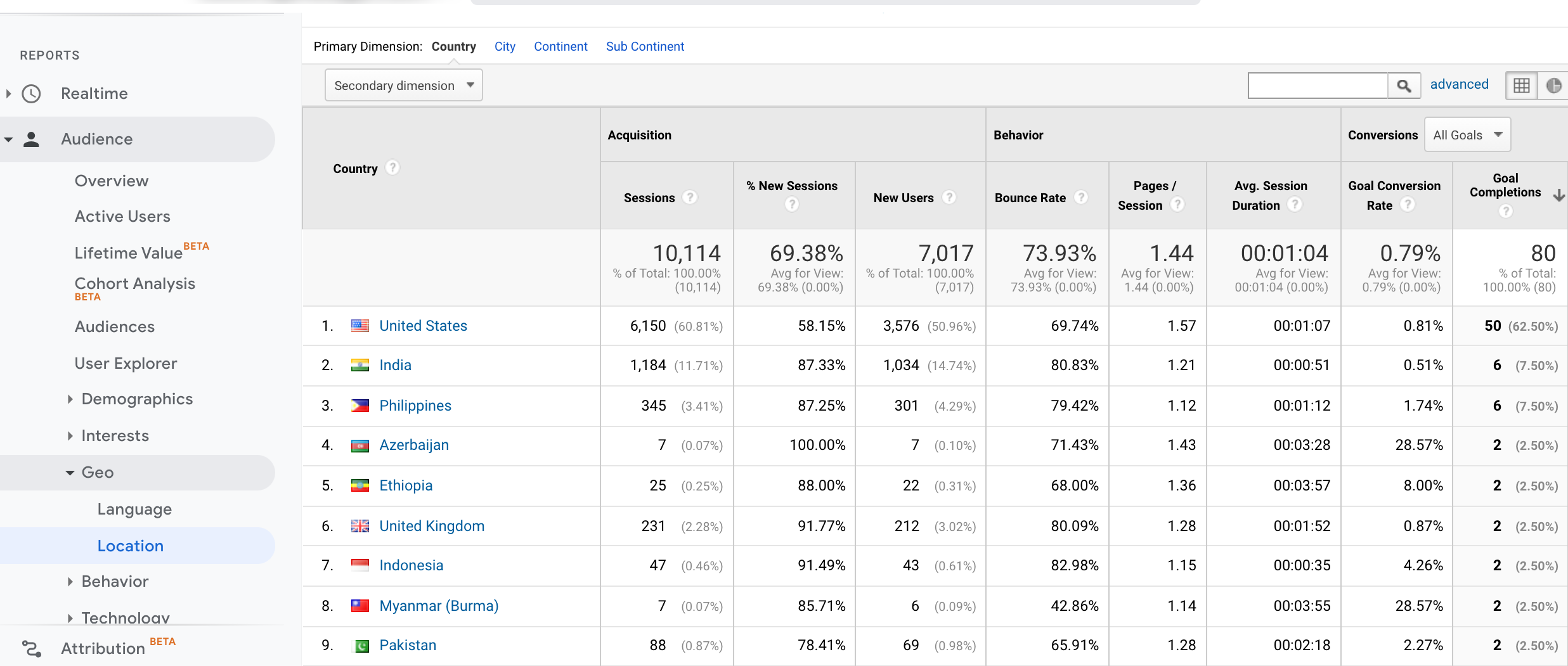 Screenshot from Google Analytics, August 2021
Screenshot from Google Analytics, August 2021
One way to help clean your data for the future in this regard is by way of account or view-level filtering to restrict tracking of specific countries or states.
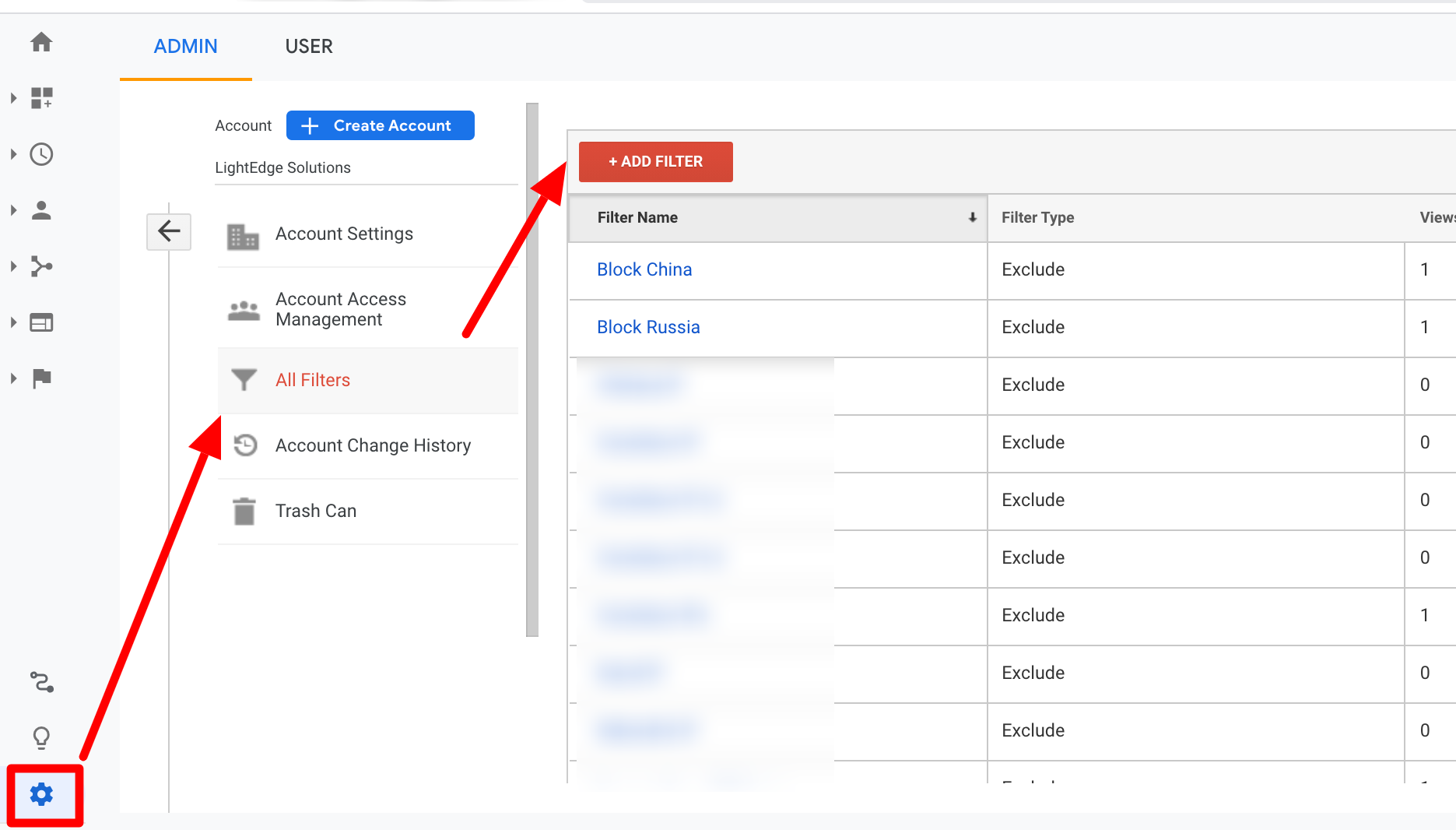 Screenshot from Google Analytics, August 2021
Screenshot from Google Analytics, August 2021
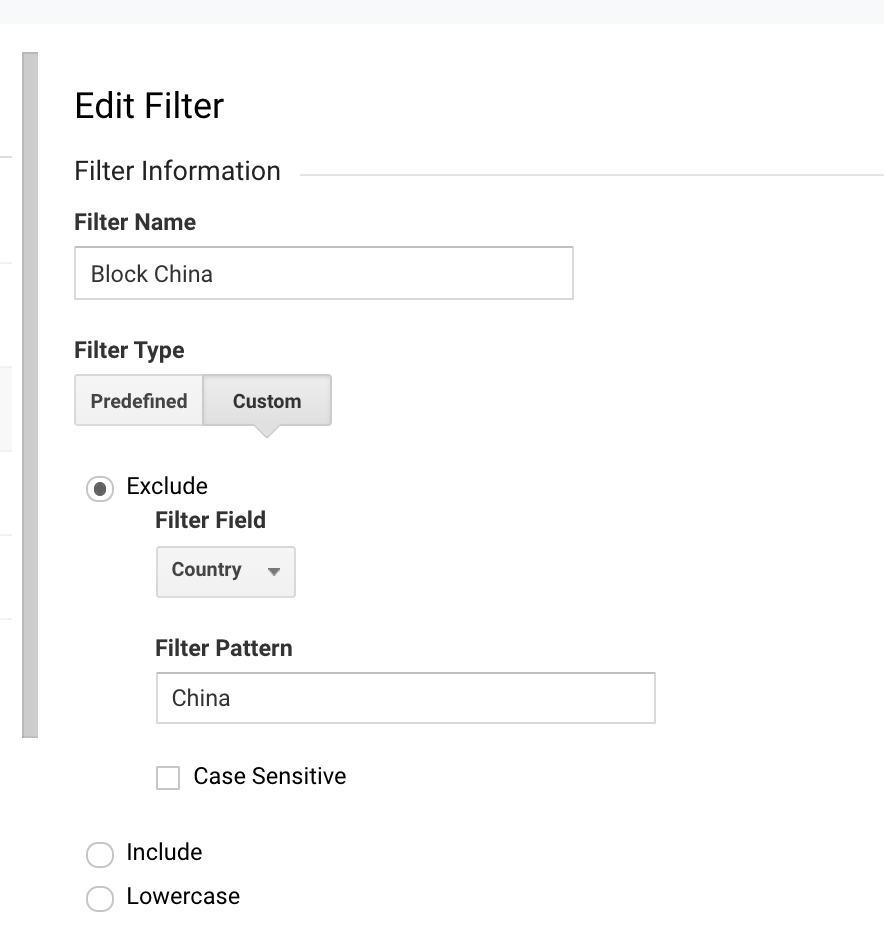 Screenshot from Google Analytics, August 2021
Screenshot from Google Analytics, August 2021
9. Connect Your Data
Another benefit of using Google Analytics is that this is one resource from a large family of offerings. In this, you have the ability to integrate multiple efforts together.
Advertisement
Continue Reading Below
Consider this “Dr. Google’s Health Report” for your site.
Given the ability to understand the visibility of pages in search as well as potential crawling issues, it is an essential tool for the digital marketer.
Integrating Google Search Console with your Google Analytics does not provide new data but the ability to marry data together to create insights from a single display.
Google Search Console
For example, Google Analytics gives us a view of landing page sessions and goal attribution but with Google Search Console integration we can now see this plus impression and average position dissection for landing pages.
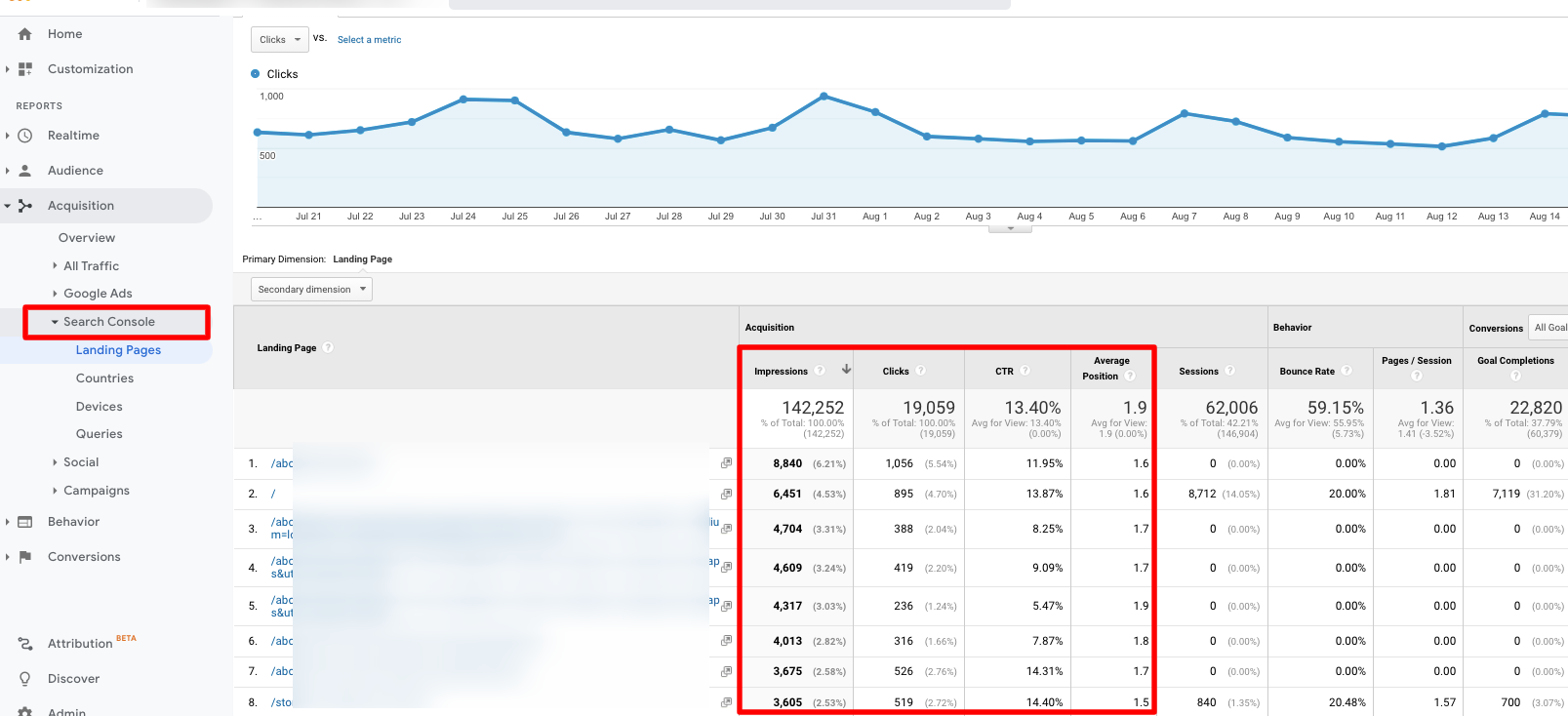 Screenshot from Google Analytics, August 2021
Screenshot from Google Analytics, August 2021
To achieve this integration, enter the Admin area of your account and within the Property Setting section, you will see the Adjust Search Console button. This allows you to add the correlating Google Search Console account.
Advertisement
Continue Reading Below
It helps if they are both Admin access from the same email address.
If not, you will have to allow the email from the Google Analytics account as a user in the console account.
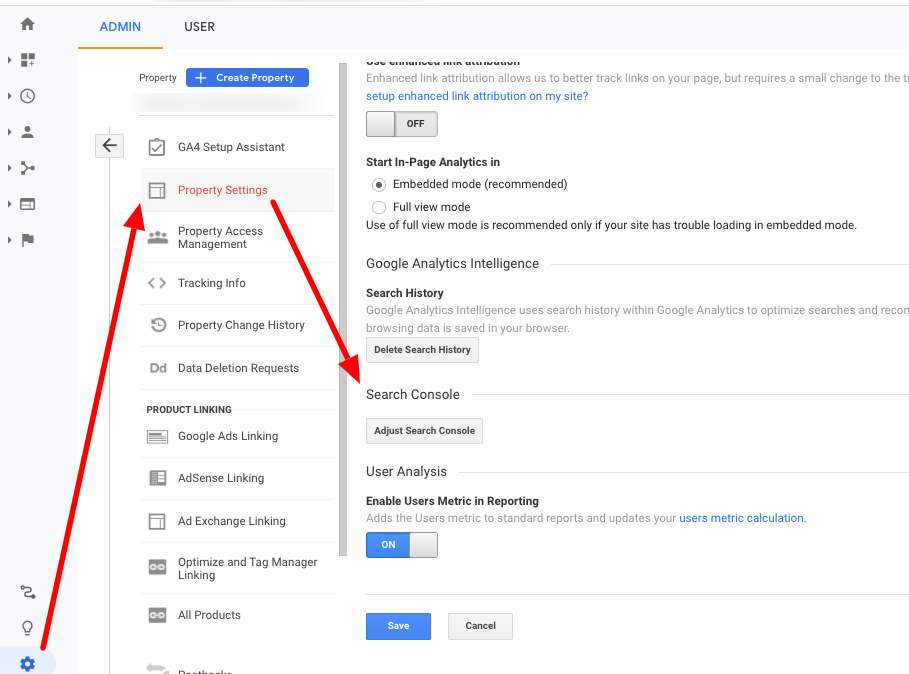 Screenshot from Google Analytics, August 2021
Screenshot from Google Analytics, August 2021
Google Ads
Another connection which is extremely important to the collection of your analytical goal completions is the pairing of Google Ads to your Google Analytics account.
Picture this as paid search, YouTube, and Display advertising goal attribution clarity.
Advertisement
Continue Reading Below
If not set up, you may find goal data showing up under the wrong default channel grouping in Google Analytics.
The benefit of this bridge is that while Google Analytics gave us website user behavior insight, Google Ads can bring in respective landing page, device, etc. data regarding CTR and cost data for an all-encompassing performance review.
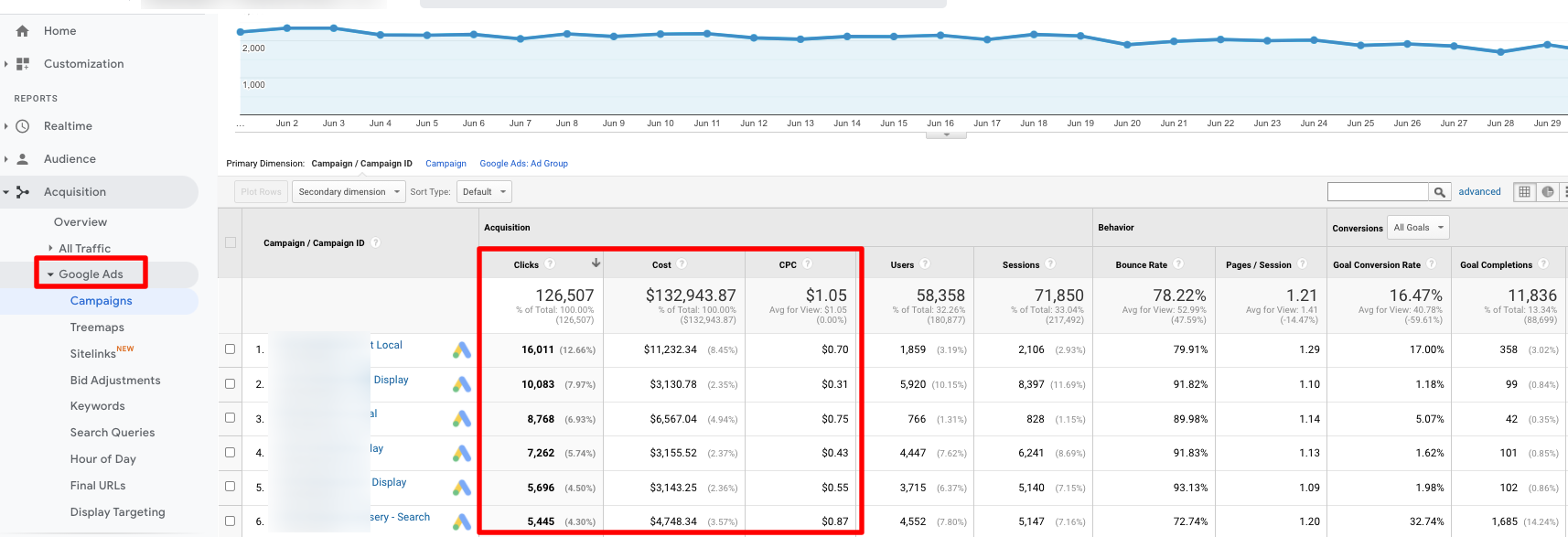 Screenshot from Google Analytics, August 2021
Screenshot from Google Analytics, August 2021
Again, it is easier to connect these two if access if both properties are administrated from the same email address, or else you will have to share user access in either property.
Advertisement
Continue Reading Below
Moving on, click into your Admin area of your account, and within your Property Settings,
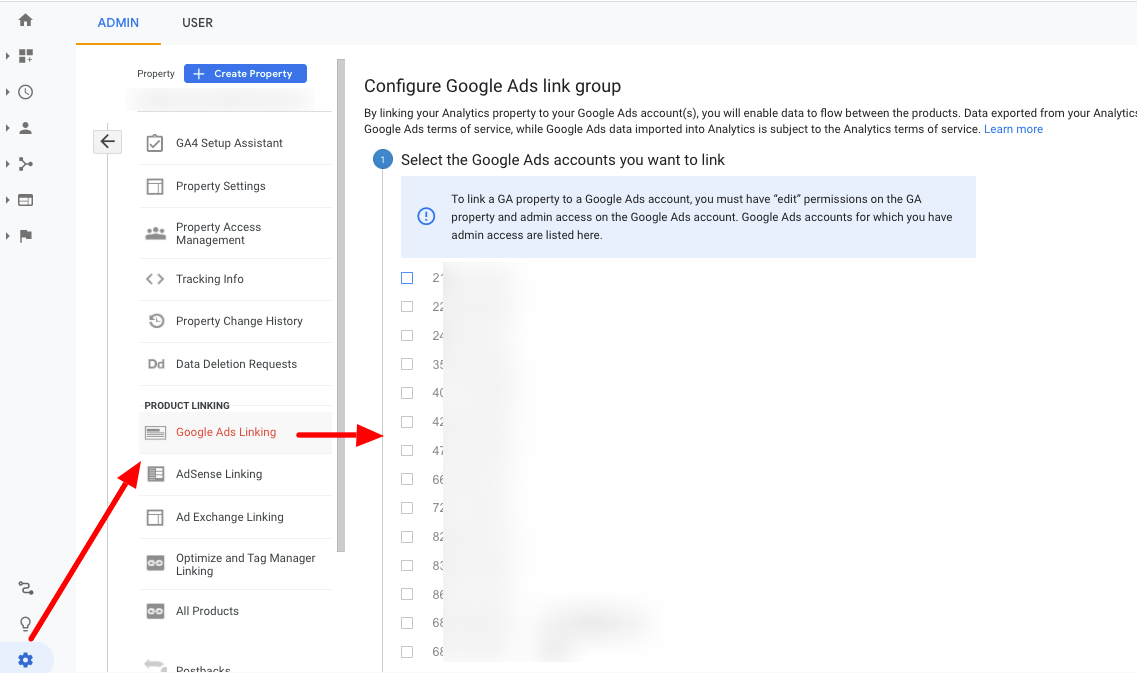 Screenshot from Google Analytics, August 2021
Screenshot from Google Analytics, August 2021
10. Report on Your Data
Congratulations, you have set up your Google Analytics goals, verified accuracy, monitored, dissected and even taking advantage in pairing other Google properties!
Now it’s time to report on this so you and others can enjoy all of your insightful data.
For those who want to keep their data efforts close at hand and within one platform, Google Analytics offers Dashboards and Custom Reports.
Advertisement
Continue Reading Below
Dashboards
Dashboards are a great way to provide insightful visuals to organizational members who want to better understand KPIs and goal conversion from a more aesthetic view.
They are a quick way to choose data layouts and integration high-level data. The data here is exportable and can also be set up as scheduled emails.
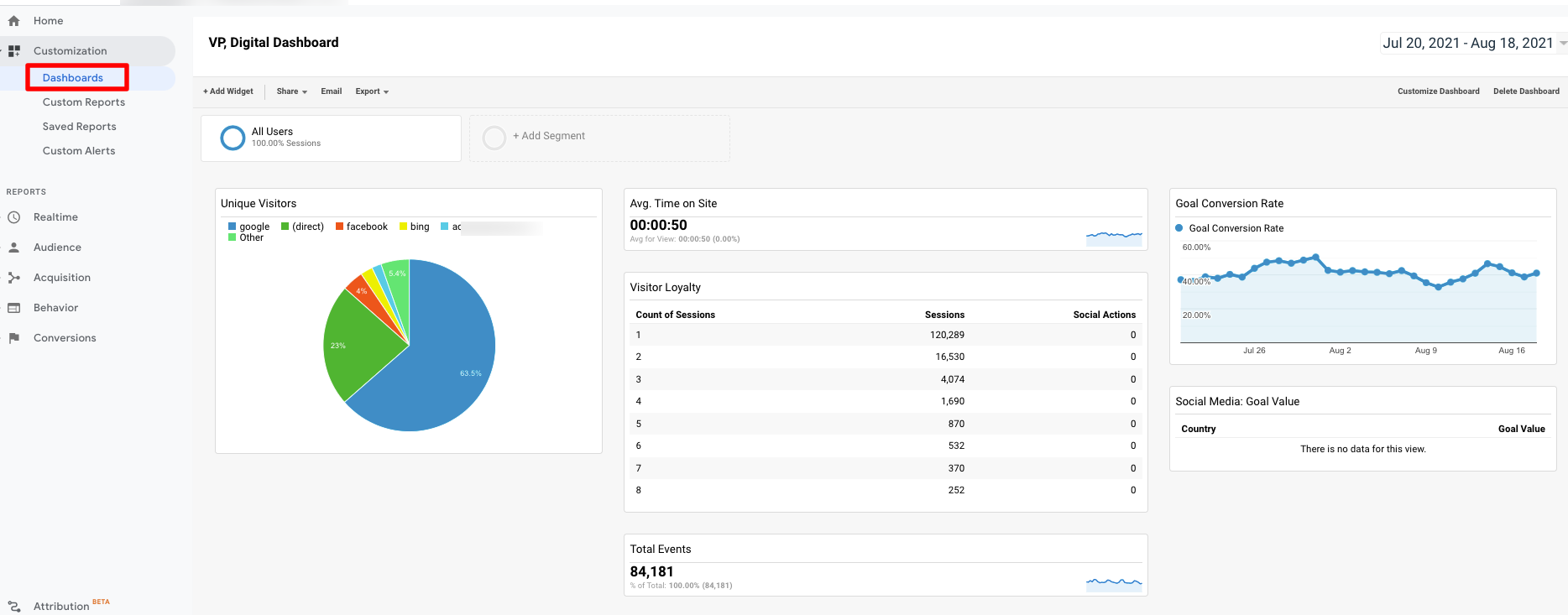 Screenshot from Google Analytics, August 2021
Screenshot from Google Analytics, August 2021
Custom Reports
Custom Reports can be seen as dashboards taken to the next level. These are often created by an analyst for review by those that are likely more analytically inclined.
Advertisement
Continue Reading Below
While less visually appealing, Custom Reports allow you to bring data together by View as well as data filters.
Again, this option allows you to email or export data.
 Screenshot from Google Analytics, August 2021
Screenshot from Google Analytics, August 2021
Summary
Having properly configured Google Analytics goals will give you the opportunity to truly understand your website audience – who they are, what they are doing, and whether they are converting to your identified site objectives.
Robust analytical data is what establishes campaign benchmarks and, most importantly, will help formulate your marketing strategy.
Advertisement
Continue Reading Below
More Google Analytics Resources:
How to Understand User Behavior With Google AnalyticsHow to Use Google Analytics: A Complete GuideA Guide to Essential SEO Tools for AgenciesFeatured Image: FGC/Shutterstock

 Fransebas
Fransebas 































